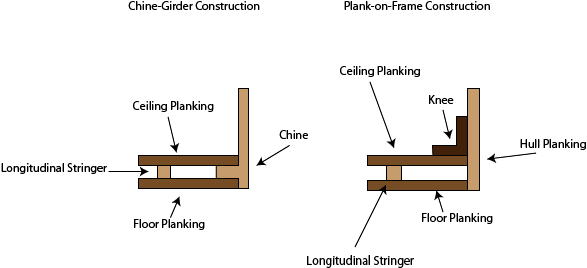Following the settlement of the Carolinas by European colonists, the colonists began experimenting with the various types of vessels that could be used in the inland waterways of the area for transporting things to and from plantations. With the need for quick and regular on and off-loading, the settlers of the region began constructing large, flat bottom barges. These barges came in two types: plank-on-frame and chine-girder construction.
Barge Usage
Since the founding the of the Carolina colony in the 17th century, the leaders of the colony recognized that this region was well suited for the construction of a ferry system. This ferry system was laid out in a series of stops along the rivers and allowed people, animals, and goods to travel up and down the rivers in the Carolina area. By the 1700s, newspaper ads showed that this system was well established and had vessels regularly traveling through the area. There also appears to have been both a public and private system, as shown by the newspaper ads of the time. These ferries were constructed using the standard barge methods at the time and thus were either chine-girder or plank-on frame constructed (Newell 1997:21-26).
Barges in the Carolinas also had an important usage in the plantation industry. Since many plantations in South Carolina were rice plantations and the cultivation of rice involved vast irrigation networks, boats became crucial for this industry. The barges in this industry were divided into two types: larges ones for harvesting the rice and smaller ones for ferrying people through the fields, carrying small amounts of rice, and repairing the irrigation systems found. Both chine-girder and plank-on frame construction barges have been found to have been used by plantation owners, and some have used both types simultaneously, making the reason for the different construction methods unknown (Newell 1997:26-32)
Following the Civil War, plantations obviously ceased to exist in the manner in which they had existed before. This change led to the near extinction of the plantation boats mentioned above, however, the design influenced later boats such as the industrial barge that transported minerals for fertilizer throughout the Carolinas Newell 1997:41-61).
The last type of flat barge used in the Carolinas is the canal boat. These barges were constructed solely to travel through the canals of the states. The canal system limited the size of ships to fifty feet in length, nine feet in width, and no more than two and a half feet deep. Despite the depictions of these vessels in the literature, the actual form of these boats seems similar to the canal craft common in England during the same time. It is assumed that these vessels were constructed with multiple decks, cabins, and hatches (Newell 1997:32-41).
Construction of Barges
Above there is mention to two types of barge construction: chine-girder construction and plank-on-frame construction. The difference between the two types of construction is shown below.

(Image Courtesy of Caleb O’Brien 2021)
As shown above chine-girder construction is identified though use of a single ‘chine’ piece that connects directly to the floor and ceiling planking. This chine would be cut from a single timber in the shape needed and would run on both starboard and port sides of the vessel. Plank-on-frame construction meanwhile is a system where planks were attached to the floor and ceiling planking through the use of a knee.
By Caleb O’Brien
